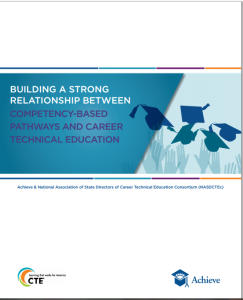![]() In October 2020, Advance CTE released “The State of Career Technical Education: An Analysis of States’ Perkins V Priorities,” which examines how states have leveraged the development of the Strengthening Career Technical Education for the 21st Century Act (Perkins V) state plans to expand quality and increase equity within their Career Technical Education (CTE) systems.
In October 2020, Advance CTE released “The State of Career Technical Education: An Analysis of States’ Perkins V Priorities,” which examines how states have leveraged the development of the Strengthening Career Technical Education for the 21st Century Act (Perkins V) state plans to expand quality and increase equity within their Career Technical Education (CTE) systems.
Attracting and retaining qualified and diverse CTE instructors remains one of the most persistent challenges facing states. Last year, ACTE held a Teach CTE Summit to more closely examine teacher pipeline challenges, surfacing numerous key issues and recommendations. According to previous Advance CTE research on this issue, 86 percent of State Directors reported a moderate or severe CTE teacher shortage in at least one Career Cluster at the secondary level, and a further 60 percent indicated the same at the postsecondary level.
The underlying causes for these shortages most often relate to the difficulties CTE programs have in competing with the private sector for the same pool of qualified instructors, along with the fact that many universities have closed their CTE teacher preparation programs in recent years. As is the case in other sectors of the economy, the CTE teacher workforce is also aging rapidly.
At the same time, the demands on CTE instructors are rigorous. CTE instructors need strong technical knowledge and industry expertise, effective classroom management and pedagogical skills, and cultural competency to support and engage each learner on an individual basis.
Without a qualified pool of CTE professionals, one that is responsive to the needs of each learner, our country cannot effectively educate learners and prepare the future workforce. Attracting, retaining and fully developing a strong cadre of CTE professionals is therefore a crucial ingredient CTE systems need for success, and this need is reflected throughout states’ Perkins V plans.
Based on Advance CTE’s analysis of state Perkins V plans:
- Nearly three-quarters of all states (36 total) are providing targeted professional development for specific groups of educators, administrators or other CTE professionals.
- Forty-five percent of states are including quality instructors in their definitions for size, scope and quality (SSQ).
- Forty-seven percent of states are going beyond the requirements laid out in the law to prioritize supporting CTE professionals in their comprehensive local needs assessment (CLNA).
- Twenty-seven percent of states are developing explicit CTE instructor recruitment plans.
- At least seven states are addressing licensure barriers and/or are developing new pathways to licensure as an approach to strengthening CTE instructor pipelines.
Key Innovations
- Oregon aims to recruit teachers from cultural and linguistic backgrounds that reflect the state’s learner population. To achieve this goal, the state plans to partner with the Educator Advancement Council, a statewide education network focused on ensuring that the state has high-quality, well-supported and culturally responsive educators. Through this partnership, Oregon aims to create a comprehensive strategy focused on recruitment efforts in underrepresented and underserved communities. In addition to this work, the state is clarifying alternative pathways that lead to the CTE teaching profession as a means to attract industry experts and potentially further diversify the field.
- Oklahoma is dedicating more than half a million dollars annually to provide targeted scholarships for individuals seeking teacher and administrator certifications. As part of its wider efforts in this space, the state has developed a new teacher institute that provides a full year of training, coaching and mentoring for new CTE instructors. Oklahoma also makes use of a statewide learning management system — CareerTech’s Master Educator platform — to structure and provide professional development that promotes continuous learning and improvement of its CTE teachers. Finally, the state is working with local universities to provide shorter-term courses and online programs conducive to incumbent CTE teacher needs.
The Work Ahead
One area of future work is ensuring that the CTE instructor workforce is representative of the learners they serve. Only five states included any explicit recruitment activities focused on diversifying the CTE teaching field in their Perkins V plans.
Recruiting, developing and retaining qualified teachers and faculty are critical for CTE programs to be successful. As noted previously, instructors are among the most important in-school factors that contribute to the success of learners. No single policy or strategy will fully address the challenges facing states with regards to this issue. Some of these challenges have to do with issues outside the realm of CTE, such as broader terms negotiated by labor and management (e.g., teacher/faculty pay scales or tenure requirements), lack of teacher preparation programs at universities, and accreditation requirements or limitations. Only through a coordinated set of approaches can states begin to make progress on this critically important topic. Through the Perkins V planning process, states have certainly started to make significant progress in this area.
Resources
- Advance CTE Resource Center: Instructor and Leader Quality
- The State of Career Technical Education: An Analysis of States’ Perkins V Priorities
- Policy Benchmark Tool: CTE Program of Study Approval
- The State of Career Technical Education: Increasing Access to Industry Experts in High Schools
- CTE on the Frontier: Strengthening the Rural CTE Teacher Pipeline
- ACTE Quality CTE Program of Study Framework
Christina Koch, Policy Associate
Alisha Hyslop, Senior Director of Public Policy, Association for Career and Technical Education
Catherine Imperatore, Research Manager, Association for Career and Technical Education


 In
In 
 Oregon’s Gov. Kate Brown launched the
Oregon’s Gov. Kate Brown launched the 
